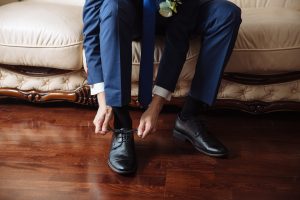Dressing for Work – Do’s and Don’ts
“What you wear is how you present yourself to the world, especially today, when human contacts are so quick. Fashion is instant language.”
—Miuccia Prada
Clothes do make a man, particularly when one has to make an impression in minutes. One’s clothes and shoes are not meant to be distractions; rather, they are tools to assert one’s presence elegantly and impressively.
While casual dressing is allowed in most workplaces today, that is not an excuse for sloppy or careless attire.
Men and women are spoilt for choice when it comes to formal or casual business wear. The rule of thumb is to wear fitted clothes. Loud colors are a strict no-no. When in doubt, stick to either white or neutral colors. For suits and skirts, dark colors are always popular – greys, browns and navy blue being the most preferred.
 Formal wear for men
Formal wear for men
- In formal settings, men can get suited up. Remember to team long-sleeved, collared shirts with slacks in conservative colors like black, grey or navy blue. Men’s trousers can be traditional cut, straight leg cut, or slim fit cut. However, it is imperative that the trousers are properly hemmed.
- Blazers must match the color of the dress slacks. If a blazer or suit coat is not mandatory, sticking to a two-piece matched suit is a safe bet.
- Ties are an integral part of power dressing. Coordinating the color of the tie with either the shirt or pants or both is essential. Solid colors and stripes are stylish, yet conservative. But, if you do want to stand out in the crowd, go for designer ties and funkier prints.
- Cufflinks and tiepins are impressive and make for an indispensable part of your formal attire.
- Wearing well-polished shoes in black or brown leather helps you put your best foot forward (pun intended). Your footwear must be comfortable and shiny and complemented by dark dress socks.
 Power dressing for women
Power dressing for women
Women in any profession are now breaking that glass ceiling. Dressing sensibly helps you appear professional and in-charge.
- Formal office wear ideally constitutes a skirt suit or dress suit teamed with a blouse. Silk and cashmere fabrics exude power and grace.
- The length of skirts worn is an important consideration. The skirt must extend to the knee or below it and must be properly fitted. Skirts should not restrict free movement of the legs or be of inappropriate length for a workplace.
- Dresses can also be worn but must be of appropriate length and color.
- Women must own a pair of patent leather heels and basic pumps for office wear. Coordinating the color of the purse carried and shoes worn goes a long way in establishing your style. Comfortable, closed-toe shoes or heels in colors like black, navy, brown, tan or taupe are chic and classy.
- Ladies must invest in good quality, sheer hosiery in shades that match the shoes and suit.
- Take time with your choice of jewelry. Dressing up for work entails wearing minimal accessories that are understated and not ostentatious. Body piercings, except the ears and nose, must not be adorned with ornaments in professional settings.
Accessories such as watches, wallets and bags can be color coordinated but should not be large and flashy. A hint of perfume or cologne adds the final touch to your wardrobe, but remember to keep it subtle and not overpowering.
Dressing up for office involves planning and effort. The care paid to personal appearance will never go unnoticed.













































